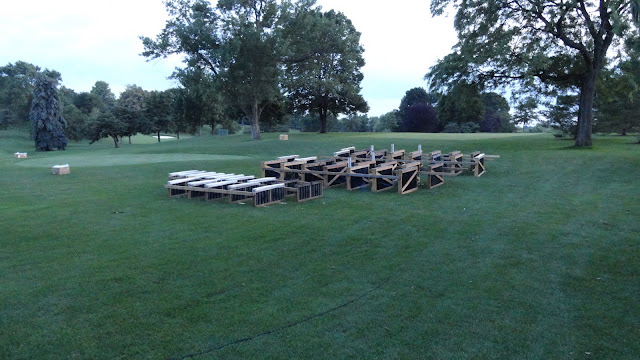Naperville Country Club, host to many a legendary golfer and recent winner of several prestigious design awards, celebrates its 90th anniversary this year.
When a group of Naperville businessmen who, enamored with the new recreational sensation sweeping the nation, applied to the state of Illinois to form the Naperville Country Club in 1921, they established a tradition that would help define the business and social lives of many Naperville families for generations.
This year marks the 90th anniversary of the venerable golf and social club that was founded during the golden age of golf in the U.S.
“The club has been one of the building blocks of the community — a center of family, business and community moments, including receptions, weddings, charity events, Rotary meetings, high school tournaments, engagements, baby showers, client meetings, company outings and golf with Dad,” says Tim Anderson, club manager and superintendent. “This is essentially a family-owned and operated small business, and it has proven to be one the most successful in the city, operating in the same location for 90 years.”
In the beginning
As the country was entering the prosperity of the Roaring ’20s, the Naperville community was growing as well. Boasting municipal services that included electricity, gas, water and sewer, paved roads, an established public school system, Nichols Library and North-Western College, the city also had a thriving business community, including several banks and retail operations and anchored by Kroehler Manufacturing. When a small group of local golfers placed an ad in the Naperville Clarion in December 1920, they were surprised to have almost 40 residents show up to a meeting at City Hall.
The group, headed by Herbert Matter Sr., Charles L. Swartz, James L. Nichols Jr., Ezra Miller and Henry E. Rennels, set about acquiring land. They settled on 130 acres of broad pasture with rolling hills and Hawthorn and Black Cherry trees belonging to Delcara Sleight, an avid golfer and daughter of Delcar Sleight. Delcar had owned a large spread of land in what are the North Central College area and the Highlands. He also had acquired the parcel south of the Burlington and Quincy tracks, known by the community as “the top of the hill” from farmer Jacob Brossman in 1868. Delcara Sleight would become the first female member of the Club.
One-hundred-twenty-two charter members paid $100 each and $25 annual dues to get the club started C.B Kroehler bought the first 10 corporate memberships.
By March, a newspaper account noted that the grounds committee, chaired by banker August Germann of Naperville Savings and Loan, was “actively clearing the grounds of stone, brush and old fences.” Theodore Boecker Jr., of Boecker Coal and Grain, loaned a team of horses to help clear the fairways.
The original nine holes with sand greens and pasture turf fairways gave way to an 18-hole regulation course designed by Tom Bendelow, known as “the Johnny Appleseed of American golf,” for the fee of $30. Bendelow, one of the nation’s leading golf course architects, would build over 650 courses, including renowned St. Charles Country Club.
Naperville’s course, featuring sloping grass greens, minimal fairway bunkers, a train platform on the fourth tee and a well for irrigation, was completed in 1927. Planned tennis courts, skeet shooting range and pool were never competed.
The original clubhouse was nothing more than a wooden shack, but the industrious women’s Porch Committee saw to it that a large porch was the center of social activities, with swings, easy chairs, hanging baskets and victrolas.
Herb Matter Sr. became the first club president. In addition to working in real estate, Matter would write a column for the Naperville Sun from 1978 to 1996.
Social club
Fran Barenbrugge, 84, joined the club in 1956 as a young executive and entertained clients there. He says he and his wife’s social life revolved around the club for many years. In addition to golf, he describes weekend pitch tournaments with 40 to 50 men playing. He also remembers escorting his wife to dances and bridge nights.
“I would take my five boys to hit whiffle balls on Sundays so my wife could go to church.” Barenbrugge remembers. “All the boys played for their high school teams; one went on to play for Western Illinois and one was the captain of the NIU team, so I guess it paid off.”
Barenbrugge’s son Dirk later became a second generation member, taking his father’s advice about entertaining customers over golf.
Renovation
With the exception of the installation of an automated irrigation system in 1966 and the loss of 32 trees to vandals in 1977, the course remained substantively unchanged until after the deluge of 1996 that brought 17 inches of rain to Naperville in 24 hours. When portions of town west of the club flooded, members began talks with design consultants Arthur Hill, Steve Forest and Associates. The result was a redesigned course that was constructed in 2006 featuring the rerouting of 13 holes, the reconstruction of tees and bunkers, a new irrigation system, Halfway House, maintenance facility, parking and pond reconstruction.
The construction included the cataloging and relocating of 150 trees, the addition of 200 new trees, the incorporation of native areas and the establishment of wetland areas. The new course also has increased wildlife, including deer, coyote, foxes, numerous birds, red tail hawks and blue heron.
Since the grand opening in 2008, the course has gained national recognition, named Golf Inc. magazine’s Renovation of the Year for private clubs, receiving Golf Course Industry Magazine’s Heritage award for Best Reconstruction and the American Council of Engineering Companies of Illinois Merit Award for Special Projects. The project was also a nominated finalist for Golf Digest’s Renovation of the Year, and earned Steve Forrest Golf Course Architect of the Year honors by Boardroom Magazine.
In addition, superintendent Tim Anderson was named master greenskeeper by the British and International Greenskeepers Association, an honor bestowed on just 49 professional superintendents in the world and only 14 in the United States. Golf Pro Jim Arendt, an active member of the PGA Quarter Century Club, has been recognized by the IPGA as a senior master for his career-long dedication to the game of golf.
“This course is a testament to the relationships and faith of the members,” says member David Tierney. “The committee brought together about 150 years of combined golf experience. When you only get to do this kind of project once every 40 to 80 years, you want to get it right.
“I think the course makes the most of the beautiful terrain, and really is a nice walk in the park. The course embraces the land so it looks like it was meant to be here.”
Best of times
Gregg Beggs, who joined in 1969, remembers sledding with the kids in the winter and golfing with them in summer, although he says they only golfed to humor him.
“I still remember my son standing on the fifth green and asking if it was time to go in yet.”
He describes the patio on a summer night as the most beautiful place to be in Naperville.
Long-time Napervillian Bev Frier joined the club in 1967 in anticipation of her first husband’s recovery from illness. Once she was widowed, friends “fixed her up” with club member Bill Frier in 1973 and encouraged the courtship. The couple was engaged six weeks later.
“I think some of my best times have been there, even though I’m not much of a golfer,” she says. “I go for the social life and the exercise.”
On her 80th birthday, girlfriends decorated her golf cart with balloons and streamers, presented her with a basket of 80 pastel golf balls, and placed pictures of her on every tee box throughout the course.
“I look back on my friendships and experiences at Naperville Country Club as among my very favorites,” Frier says. “It’s really been a big part of life here.”
Courtesy of Deborah Newman for Naperville Country Club

















































